One of the most attractive things about flowers is their beautiful reserve.
By now everyone knows that Venice is sinking three-quarters of an inch every year. Not only that, but also that restoring a villa in Italy is far from a walk in the park, since municipalities each have their own building commissions and mysterious rules dedicated to preserving local architecture.
The classic Italian garden is as carefully planned as rooms inside the Italianate villa, reflecting centuries-old Roman thinking that the surroundings of a dwelling are as significant as the design of the residence itself. Indeed, few people anywhere are as interested in the harmonious union of space and shape as those living in Italy. It’s a small wonder that even the most modest house generally has its garden—and that those gardens have inspired imitators all over the world.
Grounded in order and symmetry, labyrinthine patterns of ilex, laurel, and cypress trees frame shimmering pools and showering fountains set between gravel paths, while mazes of common box hedges and yews sculpted into spheres, cones, globes, and pyramids divide spaces into gracious outdoor rooms—arbors, pergolas, and grottoes—draped in wisteria. Foliage is in keeping with the scale of sites while sharing property rights with age-worn mythological statuary too beautiful to ignore.
Italy was also once enamored with daffodils, tulips, and paper whites. However, try as one might, bulbs often failed to thrive on a peninsula that burns in intense sunlight most of the year. After years of proving too costly and difficult to maintain, other perennials slowly vanished from classic Italian gardens, too. Instead landscapers planted strong, compelling lines of less-thirsty greenery within balustrades of stone and stucco, embraced inviting waters, and focused their creative energies on constructing imposing walls using stones quarried nearby.
In 1563, Florentine queen Catherine de Médici brought to France a penchant for thoughtfully planned, well-groomed gardens when she purchased property on the banks of the Seine from the Tuileries for an Italian-style park in the heart of Paris. But it was the Sun King, Louis XIV, and his landscape designer, André Le Nôtre, who fashioned a carpet of even more astonishing beauty—the magnificent gardens of Versailles on the outskirts of the city. With the palace meticulously centered on the site and, behind it, not a square meter of land ignored, the sweeping views gave an impression of limitless grandeur.
Born in Paris in 1613, André Le Nôtre was the son and grandson of royal gardeners. Faithful to family tradition, he succeeded his father, Jean Le Nôtre, at the Jardin des Tuileries when the latter became head gardener to Louis XIII—just as Jean Le Nôtre had followed in his own father’s footsteps at the Tuileries when he was summoned in 1592 to serve as landscaper to Queen Marie de Médici.
André Le Nôtre was recognized as a gifted engineer as well as a passionate gardener. With a fresh way of seeing the world, in 1637 he set about revamping Tuileries—originally a rubbish dump with clay soil used for making tiles (tuiles) ; hence its name. To begin with, he raised terraces, created a central lane vista, and carved out pools. Gaining momentum, he lined the grounds with trees and hedges and embellished the land with fountains, pavilions, and statuary, shaping a formal, geometric extension of the Louvre, which would soon come to be considered the world’s greatest art museum. Years later, in 1667, he would craft the regal Avenue des Champs-Élysées, giving the wide boulevard even more presence by lacing it with parallel rows of chestnut trees and planting flower gardens.
Expressing his artistic visions, Le Nôtre worked tirelessly from 1656 to 1661 producing an extraordinary masterpiece for Nicolas Fouquet, Louis XIV’s minister of finances. After redirecting one of two rivers traversing unspoiled terrain at Vaux-le-Vicomte—in the town of Seine-et-Marne, south of Paris—Le Nôtre carefully arranged a hierarchy of small spaces spawned from a central axis that swept into distant views. Flower-banked reflecting pools, basins, and waterfalls, as well as 1,200 fountains, offered further proof of his distinctive ideas and of his creative hand.
With obvious pride, Fouquet hosted a glittering fête on the evening of August 17, 1661, celebrating completion of the three-kilometer (about 1.5-mile) horticultural extravaganza. Against this backdrop of splendor and beauty, six thousand guests—including the king and his entire royal court—dined, danced, and were entertained by bursts of fireworks.
The night might have been successful had it not sparked grudging admiration and jealousy. Outside France, those familiar with the project praised the accomplishment. But while royals on the Continent sought Le Nôtre’s services, a provoked king seethed over everything—from being upstaged by breathtaking gardens to Fouquet’s glaringly obvious good taste to his failure to follow the period’s rigidly hierarchical standards of behavior.
It was universally understood that subjects were expected to obey the strict class rules of the time, and, in the king’s mind, Nicolas Fouquet’s bravura was unseemly. As a result, little more than three weeks after those gathered had applauded in delight—on September 5, the king’s twenty-third birthday—he imprisoned the minister of finances for life. To recover his lost glory, Louis XIV also sent for the artist responsible for the landscaping at Vaux-le-Vicomte, challenging him to exceed all prior triumphs at Versailles.
And it appears that Le Nôtre did. For no one would argue that he created a predilection for French gardens when most of the world was still enamored by Italian ones.
When André Le Nôtre died in 1700, France mourned the loss of the most famous landscape architect of the seventeenth century. Yet his unprecedented influence is still strongly felt as people from far-flung corners of the globe continue taking their cues from his awe-inspiring designs, including the sprawling Palace at Versailles, landscaped more than three centuries ago.
In America, emerald gardens of French and Italian descent adhere strictly to general plans that are equally mindful of the same key elements: logic, order, discipline, and beauty. Whether the land is rolling or flat, gravel paths separate well-defined patterns of squares and rectangles. Plantings sectioned into smaller beds captivatingly boast mirror images. Meanwhile, statuary, fountains, and urns spilling over with foliage add majestic dimensions to estates not necessarily as posh or formal as many of those abroad.
Appropriately, then, we salute the exhilarating style of the French and Italian people that compels interpretation half a world away. Yet we insist on scripting our own spaces, trusting our own artistry, and expressing without apology our own points of view. That André Le Nôtre disliked flowers barely matters. Blossoms brighten American spirits as we look to the future while looking back.
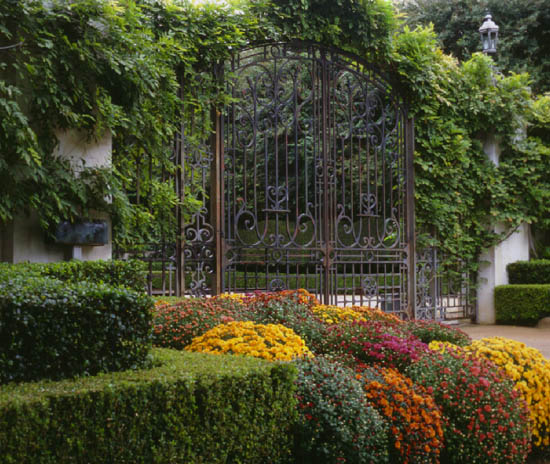
With their regal presence and overpowering beauty, wrought-iron gates hint at the graciousness within a private world reflecting the glory of France.
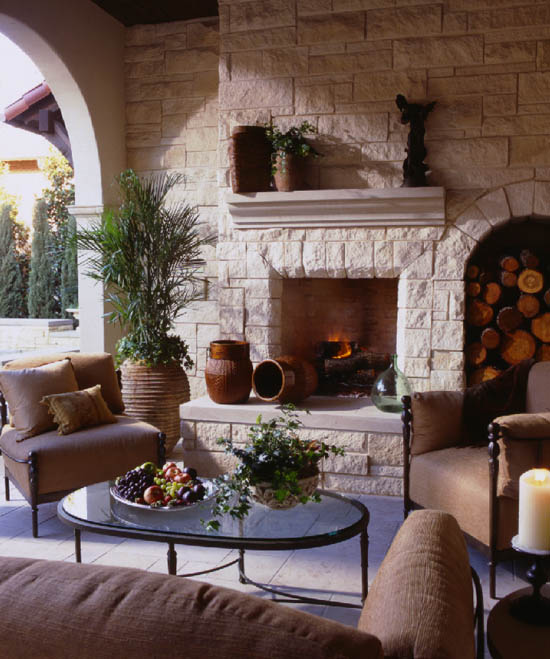
A secluded estate takes its cue from Marie Antoinette, whose summer getaway, Le Hameau, was draped in lacy swathes of heavily scented wisteria.

Seducing guests in the carefree Mediterranean mood is a spacious loggia that looks out on a pool and is designed for alfresco dining. Dramatic stucco arches supported by Tuscan-style columns add rhythm to the façade while framing the sitting area decked in weather-resistant fabrics.

With a grandeur reflecting its worldly occupants, a sumptuous château stands neither cracked nor crumbled by time. But then, it is not the typical dwelling that one sees outside a hundred French towns on the standard road trip from Paris to the Rivera. Rather, it is the ne plus ultra of châteaux —a master’s house, or maison de maitre, firmly planted on American soil.

A winding avenue leads to showering water shaded by trees.

A closed door in a stone wall signals the garden is still sleeping. But it will soon open to a parade of springtime flowers. Among the daffodils, crocuses, and tulips, antique fountains and statuary—from both France and Italy—share star billing, while urns weathered by time vie for rights to the terrace.

A stately country house with grand proportions and ivy-covered stone arches is typical of houses of European nobility. Come summer, relaxed alfresco dinners will be served on the terrace.

Water streams gently from a fountain once warmed by the Provençal sun.
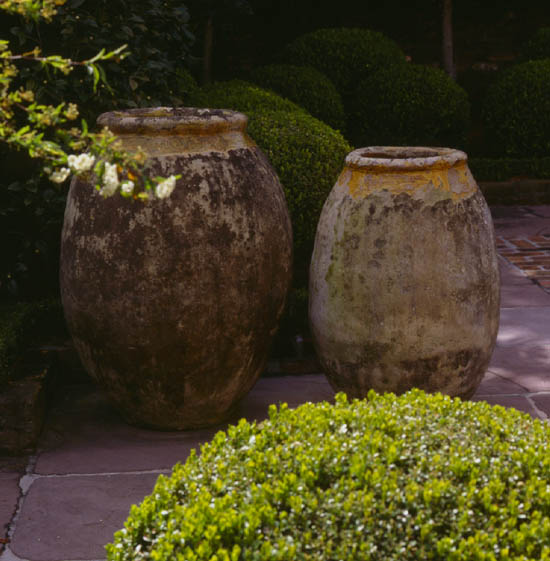
Far from their original home in Provence rest signed olive oil jars dating from the eighteenth century. More bulbous jars were made in the nineteenth century.
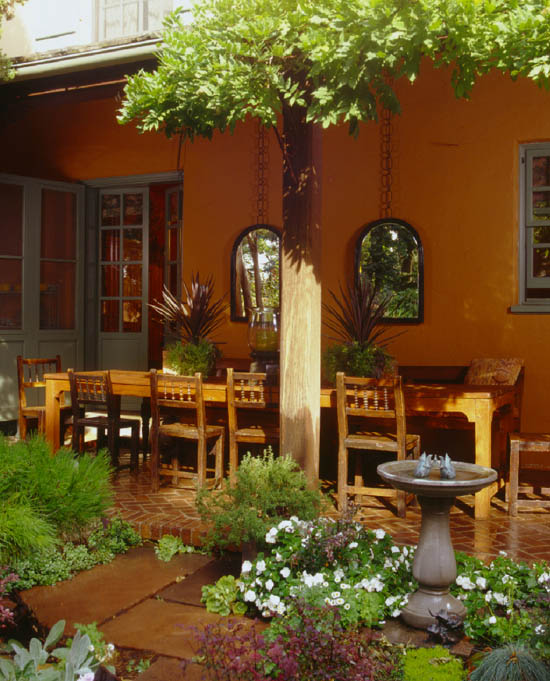
Serving as an outdoor gathering spot for alfresco luncheons, as well as a meeting point between the landscape and the David Adler house, is an arbor that frames a postcard-perfect view. Vintage Spanish chairs surround the Tuscan table.
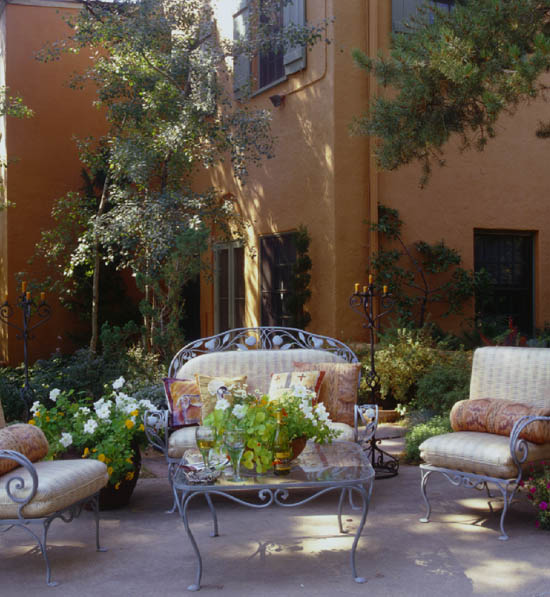
In shade cast by tall trees, heirloom iron furniture offers an ideal spot for gathering or quietly reading a book. Combining country comfort with European grandeur is an enduring Tuscan legacy left behind by American architect David Adler (1882–1949). Built in 1927 in Colorado Springs, Colorado, the house boasts the prevalent terra-cotta hue that splashes Italy.

A garden room that is a study of interesting textures and shapes has its moment in the sun. Travers cotton—woven with a chenille stripe—hangs in the windows. Matching Charles Pollack settees sport Old World Weavers fern-covered linen, while the hand-painted chest further links indoors and out. Both the chest and the coffee table are by Patina, the world’s leading maker of Venetian-inspired furnishings this side of the eighteenth century. The urn is an antique.
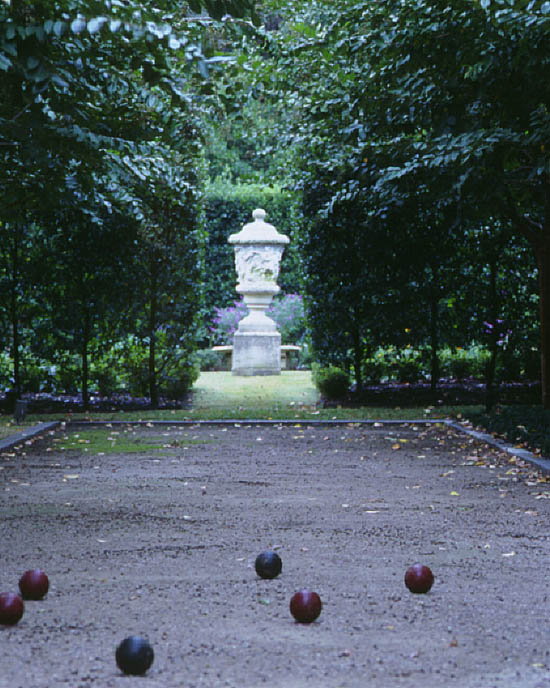
Bocce (pronounced BOHT-cheh) is the national game of Italy, enjoyed by nobility and peasants alike. The Romans learned the game from the Greeks, then introduced it throughout the empire. Much like lawn bowling, it is generally played on a long, narrow dirt court. George Washington built a bocce ball court at Mount Vernon in the last quarter of the eighteenth century.